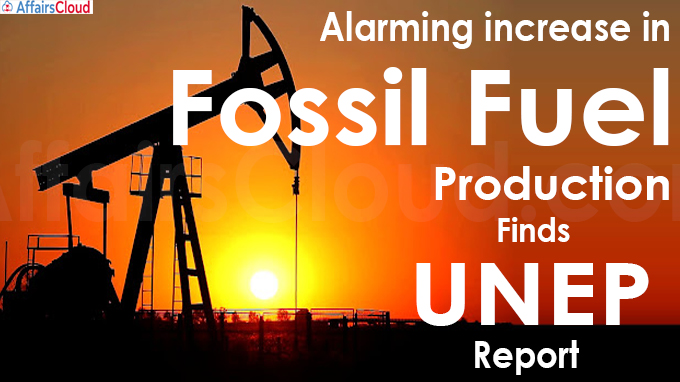 In October 2021, the United Nations Environment Program (UNEP) has released the Production Gap Report, 2021. The report analyses the ‘production gap’ i.e. the difference between governments’ plan for fossil fuel production and the globally agreed climate limits (including the Paris climate agreement).
In October 2021, the United Nations Environment Program (UNEP) has released the Production Gap Report, 2021. The report analyses the ‘production gap’ i.e. the difference between governments’ plan for fossil fuel production and the globally agreed climate limits (including the Paris climate agreement).
- As per the report, the world’s government plans to produce more than twice (around 110 percent) the amount of fossil fuels in 2030, than would be consistent with limiting warming to 1.5°C, and 45 percent more than consistent with 2°C.
- Governments’ production plans and projections would lead to the production of around 240 percent more coal, 57 percent more oil, and 71 percent more gas in 2030.
Key Findings of the Report:
i.The current report is the 3rd Production Gap Report of UNEP. The production gap has remained largely unchanged since UNEP’s first analysis (in 2019).
ii.Since the beginning of COVID-19, G20 countries have directed around USD 300 billion in new funds towards fossil fuel.
iii.Coal production: The production gap is being widest for coal (in 2030). The global countries are planning to produce 5.3 billion tonnes more coal in 2030 than is consistent with the 1.5°C.
- This production is equal to 75 percent of current levels of global coal production.
iv.The report provides country profiles of 15 countries that are planning to double the oil production by 2030 (it includes India).
v.Contrast: The international public finance for the production of fossil fuels from G20 countries and major Multilateral Development Banks (MDBs) has decreased in recent years.
India’s Profile:
i.Ambition: India’s 1st Nationally Determined Contributions (NDC), issued in 2016, pledged to reduce the ‘emissions intensity’ by 33 percent –35 percent of the economy by 2030 (compared to 2005 levels).
ii.But now, India plans to expand coal production by nearly 60 percent i.e. from 730 million tonnes in 2019 to 1,149 million tonnes in 2024. It also intends to raise oil and gas production to 40 percent during the same period.
iii.In 2020, the subsidies for coal production totalled Rs 17.5 billion (USD 249 million) and those for oil and gas production totalled Rs 29.3 billion (USD 417 million).
Note – As per the annual report (2020-21) of CIL (Coal India Limited), 69 percent of the total electricity generation of India is coal-based.
About Fossil fuel:
i.Fossil energy sources are non-renewable resources that are formed from decayed plants and animals that have been converted into crude oil, coal, natural gas, or heavy oils by exposure to heat and pressure in the earth’s crust over hundreds of millions of years.
ii.Now, the fossil fuel industries drill or mine those fossil energy sources and burn them to produce electricity, or refine them for use as fuel.
About The Production Gap Report:
i.It was 1st launched in 2019 to track the discrepancy between governments’ planned fossil fuel production and global production levels consistent with limiting warming to 1.5°C or 2°C.
ii.The current report has been prepared by UNEP along with Stockholm Environment Institute (SEI), International Institute for Sustainable Development (IISD), and think tanks such as ODI and E3G.
Recent Related News:
On September 14, 2021, three United Nations (UN) agencies viz. The Food and Agriculture Organization (FAO), UN Development Programme (UNDP) and UNEP released a report titled ‘A multi-billion-dollar opportunity: Repurposing agricultural support to transform food systems’.
The report is an analysis of countries’ support to farmers and its adverse impacts on food prices, environment, global warming and farmers, specifically smallholders.
About Paris Agreement:
i.To tackle climate change and its negative impacts, world leaders at the UN Climate Change Conference (COP21(21st Conference of the Parties)) in Paris made the Paris Agreement to reduce global greenhouse gas emissions to limit the global temperature increase in this century to 2°C while pursuing efforts to limit the increase even further to 1.5°C.
ii.The Agreement is a legally binding international treaty. It entered into force on 4 November 2016. Around 192 Parties (191 countries and European Union) have joined the Paris Agreement.




